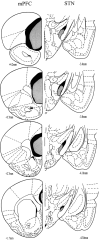Functional disconnection of the medial prefrontal cortex and subthalamic nucleus in attentional performance: evidence for corticosubthalamic interaction
- PMID: 12843247
- PMCID: PMC6741240
- DOI: 10.1523/JNEUROSCI.23-13-05477.2003
Functional disconnection of the medial prefrontal cortex and subthalamic nucleus in attentional performance: evidence for corticosubthalamic interaction
Abstract
The present study used a disconnection procedure to test whether the medial prefrontal cortex (mPFC) and the subthalamic nucleus (STN) were functional components in a common neural system that controlled continuous performance in a test of sustained and divided visual attention. Animals with disconnected lesions of the mPFC and STN in contralateral hemispheres were severely impaired in several aspects of performance, including discriminative accuracy, increased perseveration, and slowed response latencies during postoperative testing. These deficits persisted throughout the entire experimental test period. Increasing the stimulus duration alleviated the accuracy deficit but failed to improve speed of responding or reduce perseverative responses. These deficits were in marked contrast to animals with combined mPFC and STN lesions made on the ipsilateral side, which produced behavior not different from that of sham controls. Rats with unilateral lesions of either structure alone were also impaired in terms of accuracy and perseveration. These data suggest that some of the deficits observed after bilateral STN lesions (attention and perseveration) may be attributable to a disrupted corticosubthalamic projection. This study provides direct evidence that performance in tasks that require optimal attentional and executive control relies on a corticosubthalamic interaction within the neural circuitry of the basal ganglia.
Figures





Similar articles
-
Prefrontal cortical-ventral striatal interactions involved in affective modulation of attentional performance: implications for corticostriatal circuit function.J Neurosci. 2004 Jan 28;24(4):773-80. doi: 10.1523/JNEUROSCI.0949-03.2004. J Neurosci. 2004. PMID: 14749421 Free PMC article.
-
Bilateral lesions of the subthalamic nucleus induce multiple deficits in an attentional task in rats.Eur J Neurosci. 1997 Oct;9(10):2086-99. doi: 10.1111/j.1460-9568.1997.tb01376.x. Eur J Neurosci. 1997. PMID: 9421169
-
Lesions to the subthalamic nucleus decrease impulsive choice but impair autoshaping in rats: the importance of the basal ganglia in Pavlovian conditioning and impulse control.Eur J Neurosci. 2005 Jun;21(11):3107-16. doi: 10.1111/j.1460-9568.2005.04143.x. Eur J Neurosci. 2005. PMID: 15978020
-
Accurate timing but increased impulsivity following excitotoxic lesions of the subthalamic nucleus.Neurosci Lett. 2008 Aug 1;440(2):176-80. doi: 10.1016/j.neulet.2008.05.071. Epub 2008 May 24. Neurosci Lett. 2008. PMID: 18562098
-
The functional role of the subthalamic nucleus in cognitive and limbic circuits.Prog Neurobiol. 2005 Aug;76(6):393-413. doi: 10.1016/j.pneurobio.2005.09.005. Epub 2005 Oct 24. Prog Neurobiol. 2005. PMID: 16249050 Review.
Cited by
-
Separate prefrontal-subcortical circuits mediate different components of risk-based decision making.J Neurosci. 2012 Feb 22;32(8):2886-99. doi: 10.1523/JNEUROSCI.5625-11.2012. J Neurosci. 2012. PMID: 22357871 Free PMC article.
-
Human subthalamic nucleus activity during non-motor decision making.Elife. 2017 Dec 15;6:e31007. doi: 10.7554/eLife.31007. Elife. 2017. PMID: 29243587 Free PMC article.
-
Effects of Mephedrone and Amphetamine Exposure during Adolescence on Spatial Memory in Adulthood: Behavioral and Neurochemical Analysis.Int J Mol Sci. 2021 Jan 8;22(2):589. doi: 10.3390/ijms22020589. Int J Mol Sci. 2021. PMID: 33435576 Free PMC article.
-
Network modulation in the treatment of Parkinson's disease.Brain. 2006 Oct;129(Pt 10):2667-78. doi: 10.1093/brain/awl162. Epub 2006 Jul 14. Brain. 2006. PMID: 16844713 Free PMC article. Clinical Trial.
-
Unilateral vs. bilateral STN DBS effects on working memory and motor function in Parkinson disease.Exp Neurol. 2008 Apr;210(2):402-8. doi: 10.1016/j.expneurol.2007.11.011. Epub 2007 Nov 29. Exp Neurol. 2008. PMID: 18162183 Free PMC article. Clinical Trial.
References
-
- Afsharpour S ( 1985) Topographical projections of the cerebral cortex to the subthalamic nucleus. J Comp Neurol 236: 14–28. - PubMed
-
- Albin RL, Young AB, Penny JB ( 1989) The functional anatomy of basal ganglia disorders. Trends Neurosci 12: 366–375. - PubMed
-
- Baunez C, Robbins TW ( 1997) Bilateral lesions of the subthalamic nucleus induce multiple deficits in an attentional task in rats. Eur J Neurosci 9: 2086–2099. - PubMed
-
- Baunez C, Robbins TW ( 1999a) Effects of dopamine depletion of the dorsal striatum and further interaction with subthalamic nucleus lesions in an attentional task in the rat. Neuroscience 92: 1343–1356. - PubMed
-
- Baunez C, Robbins TW ( 1999b) Effects of transient inactivation of the subthalamic nucleus by local muscimol and APV infusions on performance on the five-choice serial reaction time task in rats. Psychopharmacology (Berl) 141: 57–65. - PubMed
Publication types
MeSH terms
Substances
Grants and funding
LinkOut - more resources
Full Text Sources
